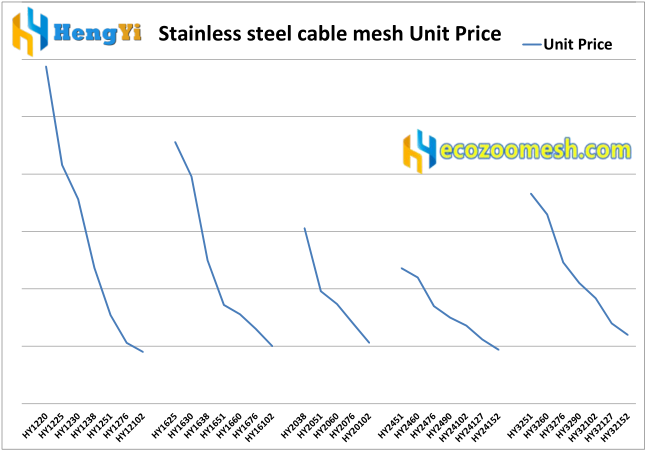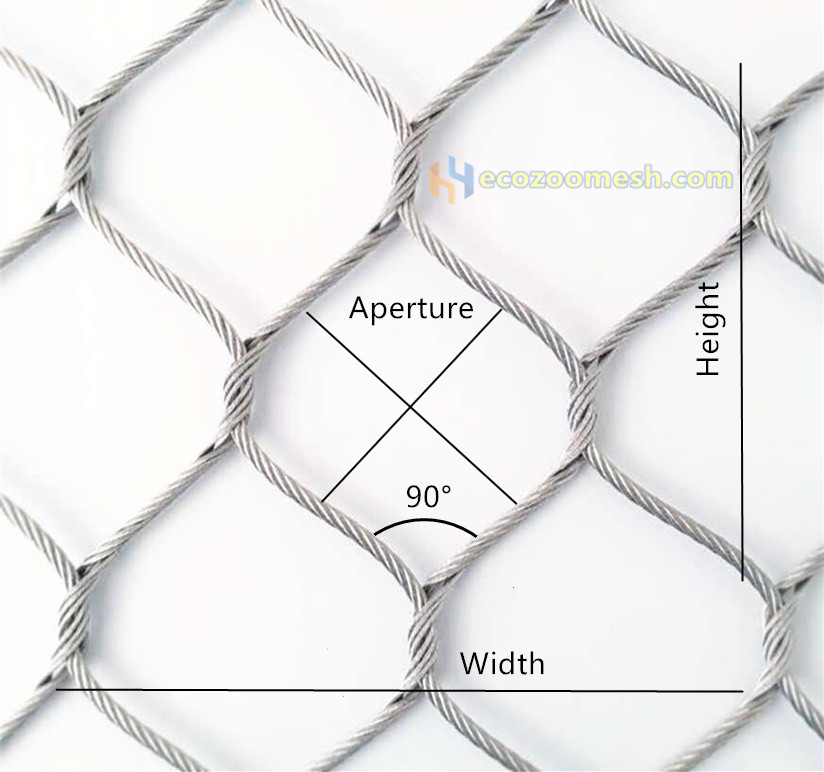How to choose the mesh aperture?
Why cannot just choose the smallest mesh aperture?
Because the aperture of stainless steel wire mesh is inversely related to the price.
The smaller the mesh aperture, that means the greater the difficulty of processing, the longer the processing steps, and the higher the processing cost, which largely determines the price of the wire rope net.
Therefore, the smaller the mesh aperture, the more expensive the wire rope mesh is.
Then, how can we choose the suitable mesh aperture?
Mesh aperture size
Under the premise of ensuring functionality, select the largest mesh aperture.
Let’s take animal enclosure mesh as an example. Usually, the size of the animal determines the mesh aperture. The specific specifications need to be selected according to the actual animal exhibit.
Other cases of wire rope applications are similar.
The following are commonly used mesh aperture:
Mesh aperture of small birds apply 20mm × 20mm, 25mm × 25mm, 38mm × 38mm.
And large birds apply 51mm × 51mm, 60mm × 60mm, 76mm × 76mm.
Monkey enclosures usually use a mesh aperture of 38mm × 38mm or 51mm × 51mm.
Fences of predatory animals as lions and tigers usually suitable for aperture of 51mm × 51mm, 76mm × 76mm.
Large animals like giraffe and sika deer are the same.
Selecting the appropriate wire rope mesh hole size can effectively reduce the project cost and budget based on the specific application.
The designers in Hengyi are willing to share with you the experience of rope mesh selection.
Here is a mesh specification table commonly used by various animals for your reference.
| Product ID | Mesh hole size | Mesh hole size | Application |
| Inch | mm | ||
| HY1220 | 0.8" × 0.8" | 20 × 20 | small birds |
| HY1225 | 1" × 1" | 25.4 × 25.4 | |
| HY1230 | 1.2" × 1.2" | 30 × 30 | |
| HY1238 | 1.5" × 1.5" | 38 × 38 | |
| HY1251 | 2" × 2" | 51 × 51 | large birds |
| HY1260 | 2.4" × 2.4" | 60 × 60 | |
| HY1276 | 3" × 3" | 76 × 76 | |
| HY1290 | 3.6" × 3.6" | 90 × 90 | |
| HY12102 | 4" × 4" | 102 × 102 | |
| HY1625 | 1" × 1" | 25.4 × 25.4 | medium birds |
| HY1630 | 1.2" × 1.2" | 30 × 30 | |
| HY1638 | 1.5" × 1.5" | 38 × 38 | |
| HY1651 | 2" × 2" | 51 × 51 | large birds |
| HY1660 | 2.4" × 2.4" | 60 × 60 | |
| HY1676 | 3" × 3" | 76 × 76 | |
| HY1690 | 3.6" × 3.6" | 90 × 90 | |
| HY16102 | 4" × 4" | 102 × 102 | |
| HY2038 | 1.5" × 1.5" | 38 × 38 | small animals |
| HY2051 | 2" × 2" | 51 × 51 | |
| HY2060 | 2.4" × 2.4" | 60 × 60 | |
| HY2076 | 3" × 3" | 76 × 76 | |
| HY2090 | 3.6" × 3.6" | 90 × 90 | |
| HY20102 | 4" × 4" | 102 × 102 | |
| HY20127 | 5" × 5" | 127 × 127 | |
| HY2451 | 2" × 2" | 51 × 51 | large and fierce animals like orangutan, monkey |
| HY2460 | 2.4" × 2.4" | 60 × 60 | |
| HY2476 | 3" × 3" | 76 × 76 | |
| HY2490 | 3.6" × 3.6" | 90 × 90 | |
| HY24102 | 4" × 4" | 102 × 102 | |
| HY24127 | 5" × 5" | 127 × 127 | |
| HY24152 | 6" × 6" | 152 × 152 | |
| HY3251 | 2" × 2" | 51 × 51 | large and fierce animals like tiger, lion, leopard |
| HY3260 | 2.4" × 2.4" | 60 × 60 | |
| HY3276 | 3" × 3" | 76 × 76 | |
| HY3290 | 3.6" × 3.6" | 90 × 90 | |
| HY32102 | 4" × 4" | 102 × 102 | |
| HY32127 | 5" × 5" | 127 × 127 | |
| HY32152 | 6" × 6" | 152 × 152 | |
| HY32203 | 8" × 8" | 203 × 203 |
See more details:PRODUCTS PAGE
If you still don't know how to choose the mesh aperture, please just contact us and we will recommend the appropriate mesh specifications based on the information you provided and our many years of experience.
We provide technical support
the company 30 years of production and installation experience
customized products, perfect service




